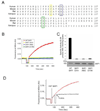BRCA1-associated protein-1 is a tumor suppressor that requires deubiquitinating activity and nuclear localization
- PMID: 18757409
- PMCID: PMC2736608
- DOI: 10.1158/0008-5472.CAN-08-0365
BRCA1-associated protein-1 is a tumor suppressor that requires deubiquitinating activity and nuclear localization
Abstract
BRCA1-associated protein-1 (BAP1), a deubiquitinating enzyme of unknown cellular function, is mutated in breast and lung cancers. In this study, we have shown for the first time that BAP1 has tumor suppressor activity in vivo by showing that BAP1 can suppress tumorigenicity of lung cancer cells in athymic nude mice. We show that BAP1 fulfills another criterion of a genuine tumor suppressor because cancer-associated BAP1 mutants are deficient in deubiquitinating activity. We show for the first time that one of the two predicted nuclear targeting motifs is required for nuclear localization of BAP1 and that a truncation mutant found in a lung cancer cell line results in BAP1 that fails to localize to the nucleus. Furthermore, we show that deubiquitinating activity and nuclear localization are both required for BAP1-mediated tumor suppression in nude mice. We show that BAP1 exerts its tumor suppressor functions by affecting the cell cycle, speeding the progression through the G(1)-S checkpoint, and inducing cell death via a process that has characteristics of both apoptosis and necrosis. Surprisingly, BAP1-mediated growth suppression is independent of wild-type BRCA1. Because deubiquitinating enzymes are components of the ubiquitin proteasome system, this pathway has emerged as an important target for anticancer drugs. The identification of the deubiquitinating enzyme BAP1 as a tumor suppressor may lead to further understanding of how the ubiquitin proteasome system contributes to cancer and aid in the identification of new targets for cancer therapy.
Figures






References
-
- Chorostowska-Wynimko J, Szpechcinski A. The impact of genetic markers on the diagnosis of lung cancer: a current perspective. J Thorac Oncol. 2007;2(11):1044–1051. - PubMed
-
- Boulton SJ. Cellular functions of the BRCA tumour-suppressor proteins. Biochem Soc Trans. 2006;34(Pt 5):633–645. - PubMed
-
- Jensen DE, Proctor M, Marquis ST, et al. BAP1: a novel ubiquitin hydrolase which binds to the BRCA1 RING finger and enhances BRCA1-mediated cell growth suppression. Oncogene. 1998;16(9):1097–1112. - PubMed
-
- Mani A, Gelmann EP. The ubiquitin-proteasome pathway and its role in cancer. J Clin Oncol. 2005;23(21):4776–4789. - PubMed
-
- Ohta T, Fukuda M. Ubiquitin and breast cancer. Oncogene. 2004;23(11):2079–2088. - PubMed
Publication types
MeSH terms
Substances
Grants and funding
LinkOut - more resources
Full Text Sources
Other Literature Sources
Medical
Molecular Biology Databases
Research Materials
Miscellaneous

